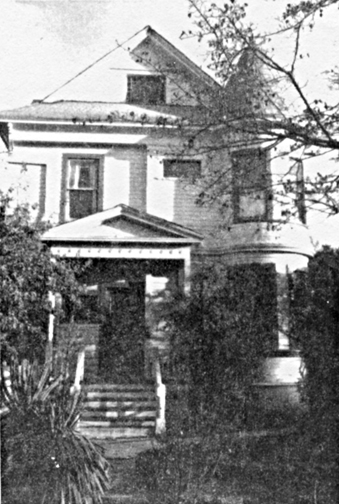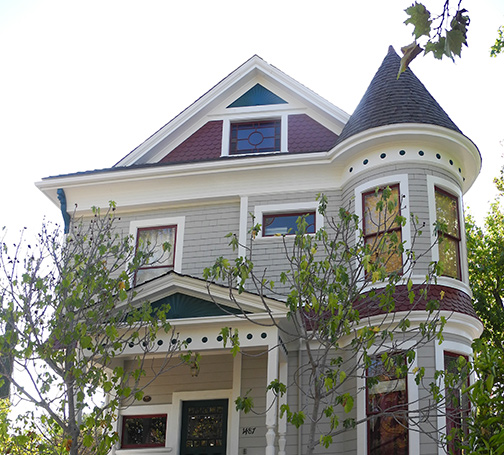 Palo Alto Stanford Heritage
Palo Alto Stanford Heritage |
 |
| Photo taken in 1978. | Photo taken in 2014. |
The following is from the Historic Buildings Inventory as revised in 1985:
This two–and–one–half story building, with its corner position and two–story bay tower is the most imposing of a group of three houses of its period in the vicinity. The newel posts of the entrance stairs are original and handsome.
This is a fine example of the towered, bay–windowed middle–class Queen Anne residence and an important part of an evocative group (with 1528 and 1531–35 College Avenue). According to Birge Clark, born nearby in 1893, it was one of the original "come on" houses, intended to attract residents to the College Terrace development of Alexander Gordon. It was called the "Red House" because of its color. As was the case for all the early Mayfield houses, indoor plumbing and external piping was added some years after construction.
Early occupants are not identifiable, but in 1910, Gordon sold the house to Ella F. Ward, and the following year it was rented (later sold) to Mrs. Julia Murphy, widow of John Murphy.
The Murphys were early farmers and landowners in the Mayfield area. They traded part of their land for an equal acreage to Peter Coutts in the area west of town served by Palo Mill Road. Mrs. Murphy's sons, John and Daniel and their wives, Rose and Ruey lived with her.
John T. Murphy (Junior) rose to be chief clerk in the San Francisco office of the Southern Pacific Railway Co.
Daniel became a well–to–do rancher, in Colusa County, after youthful labors as a tile–setter on the mosaics of the Stanford Memorial Church, and as a bicycle racer. In addition to management of his almond and walnut ranches, he established a rice irrigation business, was owner of a gun club in Colusa County, and was an avid hunter. The Murphys left the house in the mid–1920s (although an F. J. Murphy re–appears briefly in 1939–1940.
During the 1930s, the occupant was Michael Sullivan, and in the 1940s, Burr M. White. Louis Ringseis is listed as owner during much of the 1950s, succeeded until the mid–60s by John O'Hara. After that, there were numerous short–term tenants.
The following is from the Centennial Buildings Tour, prepared by The City of Palo Alto Historic Resources Board for the Centennial Building Celebration, April 16, 1994. The houses included on the tour were all identified as at least 100 years old:
The Red House, named for its original color, was one of College Terrace developer Alexander Gordon's original model homes dubbed by him "Come On" houses. Originally located at 702 Palo Alto Avenue, its two–plus stories complement the handsome Queen Anne facade and corner tower with conical roof.
Robert Brandeis photo Location map This house was built in the early 1890s and is a Category 3 on the Historic Buildings Inventory. The original architect and builder are unknown. In 1925, L. Olofson was the builder for remodeling. The property measures 50 by 100 feet.
Sources: Palo Alto and Mayfield City Directories; Palo Alto Times 5/19/27, 4/30/69, 10/10/72; Book 373 (Deeds), p. 462, 7/21/1910; book 423 (Deeds), p. 144, 10/6/14; Book 183 (Off. records), p. 323, 6/16/25; Book (Off. Records), p. 287, 12/29/26; U.S. Census, Santa Clara County, Roll 105, ED 59, p. 11
E-mail us at either webmaster@pastheritage.org or president@pastheritage.org.
![]() Palo Alto Stanford Heritage—Dedicated to the preservation of Palo Alto's historic buildings.
Palo Alto Stanford Heritage—Dedicated to the preservation of Palo Alto's historic buildings.
Copyright © 2015 Palo Alto Stanford Heritage. All rights reserved.